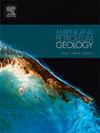Extreme sulfur isotope heterogeneity in individual Ediacaran pyrite grains revealed by NanoSIMS analysis
IF 3.7
2区 地球科学
Q1 GEOSCIENCES, MULTIDISCIPLINARY
引用次数: 0
Abstract
Pyrite sulfur isotopic composition (δ34Spy) is a crucial proxy for reconstructing ancient Ediacaran marine environments. However, recent in situ isotopic analyses of sedimentary pyrite have revealed distinct δ34Spy signatures among different pyrite morphologies, indicating that secular changes in bulk δ34Spy may reflect variations in proportions of different pyrite morphologies rather than environmental signals. Up to now, intragrain isotopic patterns within individual pyrite grains have not yet been extensively investigated for Ediacaran samples. The absence of this specific data set has hindered our ability to understand current complexities of bulk δ34Spy in reconstruction paleoenvironment. This study aims to elucidate δ34Spy patterns by conducting in situ isotopic analysis on pyrite grains from Ediacaran drill-core samples. We employed scanning electron microscopy (SEM), energy dispersive spectrometer (EDS), Raman spectroscopy, and nanoscale secondary ion mass spectrometry (NanoSIMS) to examine the crystal texture, element atomic ratios (S/Fe), mineral composition, and in situ isotopic composition within single pyrite grains. SEM-EDS observations reveal that the euhedral/subhedral pyrite crystals generally exhibit uniform mineral texture, although some grains show varying degrees of dissolution edges and surface cavities. Raman spectroscopy demonstrates the possible presence of pyrrhotite mineral within pyrite grains at some specific sites and points. In situ isotopic analysis reveals significant intragrain δ34S heterogeneity, with difference reaching up to 69.3‰ on a micrometer scale. Distinct deposition depths and burial rates may contribute to the varying value ranges and degrees of isotopic heterogeneity amongst pyrite grains. A model suggesting rapid precipitation from numerous nucleation sites simultaneously could account for the observed intragrain heterogeneity of in situ δ34S values. Pyrite grains exhibit general atomic S/Fe ratios of > 2, potentially due to the presence of trace elements incorporated into the pyrite structure. The occurrence of pyrrhotite leads to a slightly positive correlation between in situ δ34Spy values and S/Fe ratios, yet the 32S-enriched pyrrhotite plays less substantial in generating intragrain δ34S heterogeneity of pyrite grains. Our findings reveal clear isotopic heterogeneities within individual pyrite grains, in addition to the notable δ34Spy differences among pyrite of various morphologies. These results highlight significant microenvironmental heterogeneity and dynamic sulfur pool mixing on rapid short-term timescale during pyrite growth.
通过纳米SIMS分析揭示埃迪卡拉黄铁矿单个晶粒中的极端硫同位素异质性
黄铁矿硫同位素组成(δ34Spy)是重建古代埃迪卡拉海洋环境的重要替代物。然而,最近对沉积黄铁矿的原位同位素分析表明,不同形态的黄铁矿具有不同的δ34Spy特征,这表明大体积δ34Spy的长期变化可能反映了不同黄铁矿形态比例的变化,而不是环境信号。迄今为止,尚未对埃迪卡拉纪样本中单个黄铁矿晶粒内部的同位素模式进行广泛研究。这一特定数据集的缺失阻碍了我们了解当前重建古环境中块状δ34Spy的复杂性。本研究旨在通过对埃迪卡拉钻孔岩芯样本中的黄铁矿颗粒进行原位同位素分析,来阐明δ34Spy的模式。我们采用扫描电子显微镜(SEM)、能量色散光谱仪(EDS)、拉曼光谱和纳米级二次离子质谱(NanoSIMS)来研究单个黄铁矿晶粒的晶体纹理、元素原子比(S/Fe)、矿物成分和原位同位素组成。扫描电子显微镜-电子显微镜(SEM-EDS)观察结果表明,尽管有些晶粒显示出不同程度的溶解边缘和表面空洞,但八面体/亚面体黄铁矿晶体总体上呈现出均匀的矿物纹理。拉曼光谱显示,在黄铁矿晶粒的某些特定部位和点上可能存在黄铁矿矿物。原位同位素分析显示,晶粒内部的δ34S存在明显的异质性,在微米尺度上,差异可达69.3‰。不同的沉积深度和埋藏率可能是造成黄铁矿晶粒间同位素异质性值范围和程度不同的原因。一个表明同时从许多成核点快速沉淀的模型可以解释所观察到的原位 δ34S 值的粒内异质性。黄铁矿晶粒的原子 S/Fe 比率一般为 > 2,这可能是由于黄铁矿结构中含有微量元素。黄铁矿的存在导致原位δ34Spy值与S/Fe比值之间略呈正相关,但富含32S的黄铁矿在产生黄铁矿晶粒内部δ34S异质性方面的作用较小。我们的研究结果表明,除了不同形态的黄铁矿之间存在明显的δ34Spy差异之外,单个黄铁矿晶粒内部也存在明显的同位素异质性。这些结果凸显了黄铁矿生长过程中显著的微环境异质性和短期时间尺度上的动态硫池混合。
本文章由计算机程序翻译,如有差异,请以英文原文为准。
求助全文
约1分钟内获得全文
求助全文
来源期刊

Marine and Petroleum Geology
地学-地球科学综合
CiteScore
8.80
自引率
14.30%
发文量
475
审稿时长
63 days
期刊介绍:
Marine and Petroleum Geology is the pre-eminent international forum for the exchange of multidisciplinary concepts, interpretations and techniques for all concerned with marine and petroleum geology in industry, government and academia. Rapid bimonthly publication allows early communications of papers or short communications to the geoscience community.
Marine and Petroleum Geology is essential reading for geologists, geophysicists and explorationists in industry, government and academia working in the following areas: marine geology; basin analysis and evaluation; organic geochemistry; reserve/resource estimation; seismic stratigraphy; thermal models of basic evolution; sedimentary geology; continental margins; geophysical interpretation; structural geology/tectonics; formation evaluation techniques; well logging.
 求助内容:
求助内容: 应助结果提醒方式:
应助结果提醒方式:


